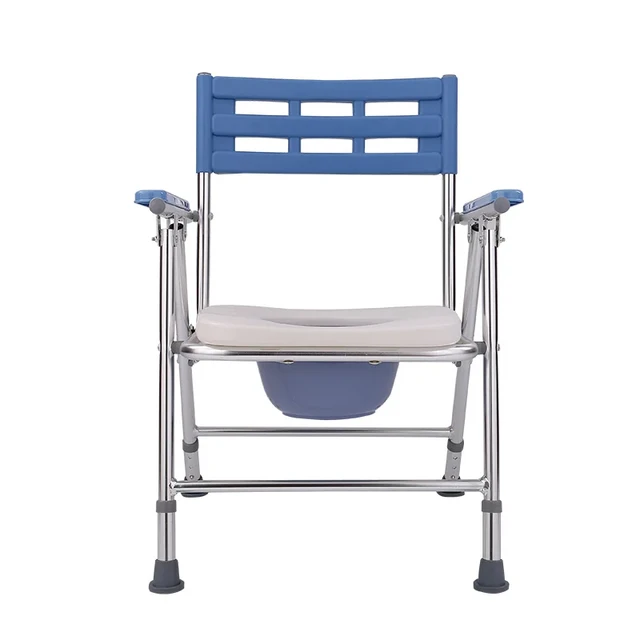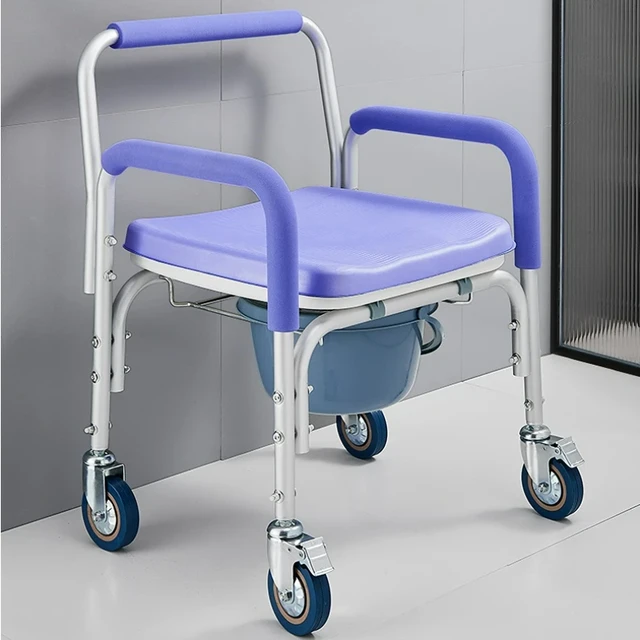 Introduction:
Introduction:
A toilet chair for the elderly is a specially designed bathroom aid that offers support and comfort for individuals with mobility challenges. With its ergonomic design and convenient features, a toilet chair provides stability and ease of use, ensuring a safe and independent toileting experience. In this comprehensive guide, we will explore the benefits, features, considerations, and installation of a toilet chair for the elderly. By understanding its value and functionality, individuals and caregivers can make an informed decision to enhance the bathroom safety and well-being of their loved ones.
 Some common materials used in the construction of toilet chairs for the elderly:
Some common materials used in the construction of toilet chairs for the elderly:
Toilet chairs for the elderly are typically made from materials that prioritize comfort, durability, and ease of maintenance. Here are some common materials used in the construction of toilet chairs for the elderly:
Steel or Aluminum Frames:
The frames of toilet chairs for the elderly are often made from steel or aluminum. These materials provide strength, stability, and durability. Steel frames are sturdy and can support heavier weight capacities, while aluminum frames are lightweight and resistant to corrosion.
Plastic Seats and Armrests:
The seats and armrests of toilet chairs are commonly made from plastic. Plastic is a durable, lightweight, and easily cleanable material. High-density polyethylene (HDPE) or polypropylene (PP) plastics are often used due to their resistance to moisture and tarnishing. The plastic seats and armrests are designed to provide comfort and support while ensuring proper hygiene.
Cushioned Padding:
Some toilet chairs for the elderly may feature cushioned padding on the seat and/or armrests. This padding provides additional comfort and pressure relief during use. The padding is often covered with a waterproof and easy-to-clean fabric or vinyl material.
Non-slip Grips or Rubber Feet:
Toilet chairs may include non-slip grips or rubber feet on the bottom to enhance stability and prevent sliding when in use. This feature ensures that the chair stays securely in place and minimizes the risk of accidents or falls.
Removable Commode Buckets or Pans:
The waste receptacles or commode buckets that come with toilet chairs are typically made of plastic. These buckets are designed to be easily removed, cleaned, and sanitized after use. Plastic is preferred due to its resistance to water damage and ease of maintenance.
When selecting a toilet chair for the elderly, it is important to consider the materials used, their durability, ease of cleaning, and overall comfort. These factors contribute to the chair’s functionality and long-term usability for elderly individuals who may have specific mobility or hygiene requirements.
 Benefits of a Toilet Chair for the Elderly
Benefits of a Toilet Chair for the Elderly
Enhanced Safety and Stability:
The primary benefit of a toilet chair for the elderly is its ability to provide stability and support during transfers to and from the toilet.
This reduces the risk of falls and injuries, promoting a safer bathroom environment.
Increased Comfort:
Toilet chairs often feature padded seats and armrests, providing individuals with added comfort during use.
The ergonomic design helps reduce pressure points and discomfort, especially for individuals with limited mobility or chronic pain.
Independence and Dignity:
A toilet chair allows seniors with reduced mobility to maintain their independence and privacy in the bathroom.
It enables them to complete toileting tasks with minimal assistance, promoting a sense of dignity and empowerment.
Features of a Toilet Chair for the Elderly
Height Adjustability:
Many toilet chairs are height-adjustable to accommodate individual preferences and needs.
This feature ensures optimal comfort and facilitates easier transfers.
Armrests and Backrests:
To provide greater support and stability, toilet chairs typically have sturdy armrests and ergonomic backrests.
These features aid in maintaining balance and promote proper posture during use.
Secure Locking Mechanism:
Toilet chairs are equipped with a secure locking mechanism that attaches the chair securely to the existing toilet bowl.
This ensures stability and prevents any movement or shifting during use.
 Considerations for Choosing a Toilet Chair for the Elderly
Considerations for Choosing a Toilet Chair for the Elderly
Weight Capacity and Durability:
Ensure that the toilet chair you choose has a weight capacity that exceeds the user’s weight.
Check for durability and stability to ensure longevity and reliability.
Ergonomics and Comfort:
Consider the ergonomic design, seat padding, and armrests/backrests to select a chair that maximizes comfort for the individual.
Cleaning and Maintenance:
Look for a toilet chair that is easy to clean and maintain.
Choose materials that are resistant to water damage and offer convenient cleaning options.
Installation and Safety Measures
Installation Process:
Follow the manufacturer’s instructions carefully for installation.
Ensure that the chair fits securely on top of the existing toilet bowl, with the locking mechanism engaged.
Non-Slip Surfaces:
Place non-slip mats or strips around the toilet chair to prevent slipping or sliding during transfers.
These surfaces provide additional traction and minimize the risk of falls.
Professional Assistance and Consultation:
Seek guidance from healthcare professionals or occupational therapists who can provide recommendations specific to the individual’s needs.
They can assist in selecting the appropriate toilet chair and provide guidance on installation and safety precautions.
Main differences between a toilet chair and a regular toilet
The main differences between a toilet chair and a regular toilet lie in their design and functionality. Here are the distinctions:
Design:
A toilet chair, also known as a commode chair, is a portable chair that functions as a toilet seat. It typically consists of a frame with a seat, armrests, and sometimes a backrest. The frame can include a removable bucket or pan that serves as a temporary waste receptacle. On the other hand, a regular toilet is a fixed fixture typically found in bathrooms and includes a bowl, seat, and flushing mechanism.
Portability:
A major advantage of a toilet chair is its portability. It can be easily moved and placed in different locations, making it suitable for individuals who have difficulty accessing a regular toilet. This feature makes it useful for those who are bedridden, have limited mobility, or are recovering from surgery.
Versatility:
Toilet chairs are often used as alternatives to regular toilets, allowing individuals to use the bathroom without needing to transfer to a traditional toilet. They are commonly used in hospitals, nursing homes, or home care settings. Regular toilets, on the other hand, are the standard toilet fixtures found in residential and public bathrooms.
Waste Management:
Toilet chairs can come with a removable bucket or pan that collects waste. After use, the bucket can be removed and emptied, and proper sanitation measures can be followed. Regular toilets, with their built-in plumbing system, flush waste away for proper disposal and treatment.
Accessibility Features:
Some toilet chairs may have additional features to aid individuals with limited mobility or disabilities. These features can include adjustable heights, armrests for support, or even wheels for easier maneuverability. Regular toilets, while accessible through modifications like grab bars or raised seats, do not typically include such built-in accessibility features.
It is important to note that a toilet chair is not a permanent replacement for a regular toilet but rather provides convenience and accessibility in certain circumstances or settings. The selection of either a toilet chair or a regular toilet depends on an individual’s specific needs, mobility, and the environment in which it will be used.
 Conclusion:
Conclusion:
A toilet chair for the elderly is a valuable bathroom aid that promotes safety, comfort, and independence for individuals with mobility challenges. With its stability, adjustable features, and supportive design, a toilet chair provides seniors with the necessary assistance for safer and more confident toileting. When choosing a toilet chair, consider the benefits, features, and user requirements to ensure an optimal fit. Follow the installation instructions carefully and implement safety measures to create a secure and accessible bathroom environment. By incorporating a toilet chair for the elderly, caregivers and individuals can enhance bathroom safety, improve overall well-being, and maintain independence in daily life.



